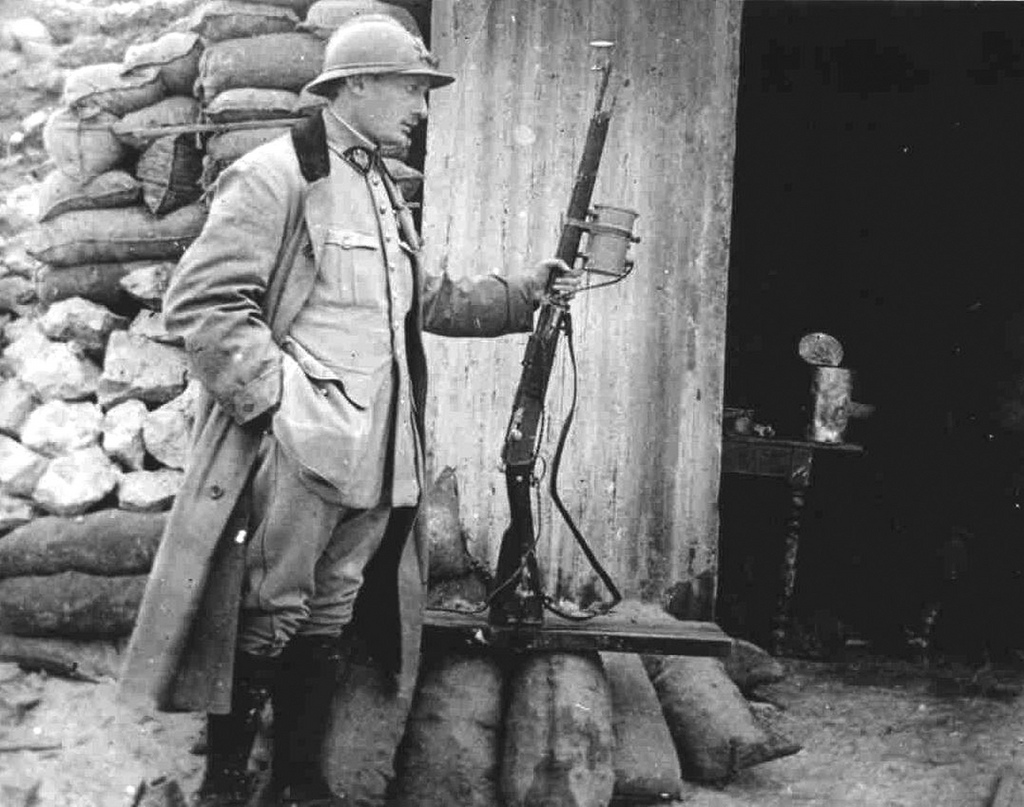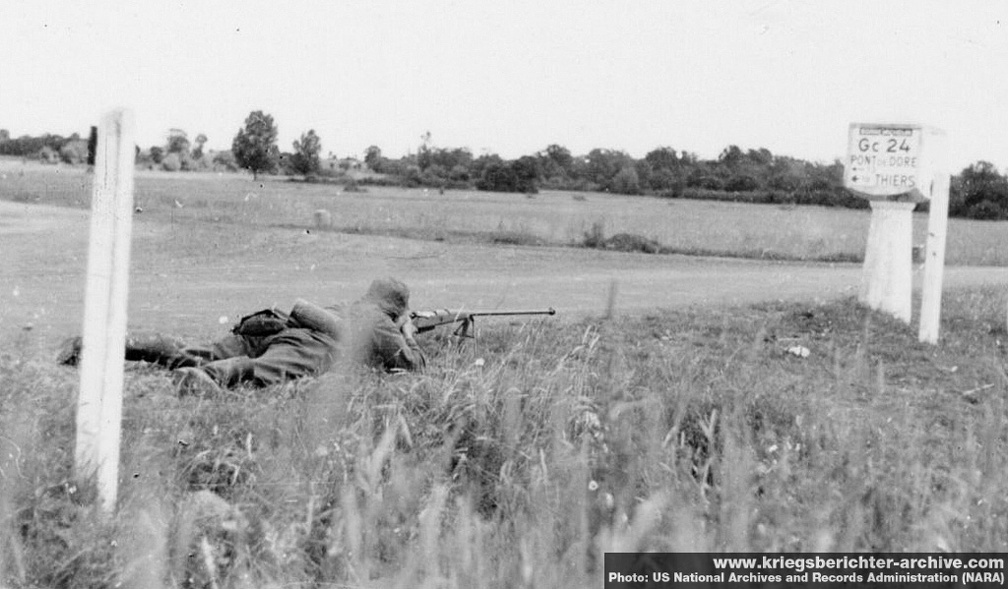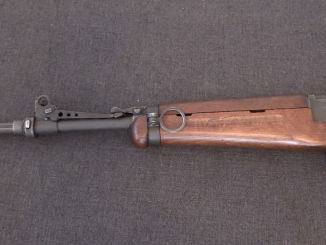Long-time reader and commenter Eon took a closer look at yesterday’s photo and recognized what I had not – it isn’t a line-throwing rifle, it’s a light mounted under the barrel. His comment in full:
The “can” definitely has an electrical connection at its bottom rear. The double-stranded line from it leads to a switch on the right side of the forearm just where the fingers of the shooter’s left hand would be placed.
The wire continues back from there, past the trigger guard. Note the “loops” hanging down, which can be mistaken for a lever-action loop (which the Lebel doesn’t have). The line goes on from there, my SWAG is to a 6V battery “off-camera”, as they would say in Hollywood.
The “can” is most likely from either a French or British Aldis lamp. It’s a light, not a line canister. Note the “bolts” top and bottom; they’re the pivot trunnions for its usual mount. It’s turned 90 degrees from its usual “up and down” orientation (like cannon trunnions).
The switch on the forearm would normally be on the lamp’s mount, behind it. A message would be “tapped out” in Morse, as on a telegraph.
This rig is intended for two jobs, I suspect;
1. “Jacklighting” German soldiers trying to creep up on the position after dark. An anti trench-raid weapon.
2. “Jacklighting” rats in the trench itself.
The light going on in the target’s face would blind them, and probably “freeze” them, for a split second, just long enough for a shot.
In each case, the procedure would literally be “Flash!- BANG!”
Thanks, Eon!





Curious, but I think is not a good idea, the Germans would shoot in the direction of the light. A similar case occurred with the capture of Berlin by the Russians
Are you referring to the Battle of Seelow Hights where the Soviets used powerful search lights in a attempt to blind the Germans? It probably was not a great idea to begin with, but there was fog which made the situation much worse for the Soviets. The beams dispersed a lot in the fog, which only did not reduce their effectiveness on the Germans, but also partially blinded the Soviets.
Whose idea was it to bring the lights, some half-witted bureaucrat?
Apparently Marshal Zhukov took the credit for it. I don’t know if it was truly his brainchild originally, but he had thought of it as a great idea and it was too late to put the blame on anybody else.
I actually remembered the part about fog incorrectly: the dispersion was caused by dust and smoke from fires started by the Soviet artillery preparation, which again by Zhukov’s orders was concentrated on the first line of German defenses. The Germans had only skeleton manning in the first line, so the huge artillery barrage was mostly wasted. Earlier Hitler’s strict orders not to yield any land voluntarily had often compelled German generals to man the first line of defense well, even if it was against the official defensive doctrine of the Heer, which called for defense in-depth, but at this stage of the war General Heinrici was able to ignore those orders.
Zhukov may have been one of best generals the Soviets had in WW2, but he for sure made his fair share of errors.
Well done Eon mystery solved
Excellent.
Most of us see what we want to see. The real exercise is in seeing what is.
Now who would like to volunteer and turn that light on in a front line trench? I for one would like to be as far away as possible.
Keep in mind that when used against infiltrators, it would be aimed from the fire step at a slight downward angle, or else pretty close to the ground level in front of the parapet. And an Aldis lamp had a lens that narrowed the beam a bit so its flashes couldn’t be seen readily by ships or stations “off-axis” from the one you were pointing it at. (They might be the enemy.)
Since the Aldis switch was a momentary spring-loaded type (push-On, let go-Off), all the shooter would have to do to “black out” would be to lift his fingers.
Also, at night, with the intruder’s (and everyone else’s) eyes adjusted to low light, a sudden flash of bright, white light would blind him. Probably long enough to get off one good aimed shot, and then- lights out.
At both ends.
It almost qualifies as a booby trap.
(Of course, that’s just my SWAG- I could be wrong, you know.)
cheers
eon
I may be wrong, but I just feel that an Aldis lamp turned on for however brief in the direction of the enemy trenches would be rewarded with some well aimed crew served weapons, machine guns or more likely artillery. The clean staff type displaying it may have thought of it, but I do not think that he was the one who turned it on in the trenches. I remember reading one German soldiers account of the fun game of eliminating, plinking, trench raiders and scouts who could not extinguish their cigars at night.
I can’t honestly see the light as being a problem for the shooter provided he keeps it brief and shifts position immediately after firing. Unless someone was ready and waiting for him, it would be all over and he would be back below the parapet before anyone could react.
Eon, you magnificent b*****d, I read your POST!
“ARRETEZ-VOUS, HANS!” [FLASH!]
“NEIN!”
Okay, Jacob was right. Just be aware that the other team will try to put your lights out (literally). And if that lamp were ludicrously intense, do you think it could give the victim lamp-burn?
Instructions for the Royal Navy-issue lamp (known as the “fog-cutter”) stated that it was unsafe to look into it at close range. Unless you liked lightly scorched retinas, that is.
I forget the exact stats, but to be able to be seen from 5 NM in 50% fog (RN standard), the lamp would have had to put out at least 5,000 candlepower. That’s nasty on the eyes at under 50 yards, especially in the dark when your pupils are dilated to pick up on low ambient light.
cheers
eon
Ouch. At least the victim didn’t get hit by a flamethrower at the same time…
Weapon of choice scenario:
In the darkness, you are either sneaking across to the opposing team’s command post or defending your trench lines. Flares for artillery barrage lighting are unusually absent on both sides. Be aware, the bodies in no-man’s land may have some that aren’t dead yet…
If you are a trench raider, pick one of the “stealthy” weapons from this first list:
1. Trench knife
2. “French Nail”
3. Bayonet
4. Katana
5. Spiked trench cudgel
6. Pedersen device on M1903 Springfield
7. Suppressed commercially available blowback pistol (like a Mauser M1914)
8. Your bare hands or a butterfly knife…
9. Screw stealth, get the Winchester 1897 with bayonet and the M17 Revolver
10. Screw stealth, get the Bergmann MP18
11. PSST! Add your favorite stealthy toys to this list!
If you are a defender, pick a weapon from this list:
1. Flash-light Lebel
2. Flare gun
3. Vickers HMG with tracers and night vision optics
4. Shotguns of any kind
5. Artillery
6. Screw this, I have a tank
7. Stealthy weapons from the first list
8. Add your favorite toys to this list!!!
This game of search and destroy is voluntary. You are not required to respond if you do not wish to do so. Please keep any and all criticism of this post humane and free of foul language.
Thank you,
Cherndog
As the infiltrator, if I’m trying Not To Be Seen, I’m going for my old friend the M1918 trench knife, plus a 1911. If I shove the muzzle of the latter right into the sentry’s gut or back before squeezing the trigger, his body acts as a sound suppressor.
As a defender, my first investment will be some preserve cans, some gravel, and some string.
My chosen weapon will be a shotgun. Dutch-loaded with slugs and buckshot. And of course, a bayonet on its business end.
😉
cheers
eon
Don’t shove much; after 1/4″ the dis-connector prevents the firearm from firing!
I know; i used to teach that trick in weapon-retention. Along with “stick your thumb between the hammer and the firing pin”.
😉
cheers
eon
Webley .455 with a bayonet
I presume you’re a trench raider with that answer…
Good choice. My preference for the 1911 is because it has no barrel-cylinder gap like a revolver, which makes the “use the target to silence the shot” trick feasible.
Contrary to Hollywood, “silencers” don’t work too well on most revolvers because there’s a good bit of gas escape- and thus noise- from the barrel-cylinder gap.
A few of the very few revolvers that could be effectively “silenced” were the Russian Nagant M1895 7.62mm, with its “gas-seal” cylinder, the similar 1970s-era Czech ZKR-551 target revolver in .38 Special, and the same decade’s Dan Wesson revolvers with their interchangeable barrels that could have their gap adjusted simply by screwing the barrel in a bit farther against a thinner gap gauge. (The gauge was actually the same type used to measure the gap on a car’s sparking plugs.)
At least one intelligence agency used .357 and .44 Magnum DW revolvers with special silenced barrels in just this way.
The combination of the .44 caliber with a heavy (250-grain) subsonic bullet (similar to modern “medium velocity” Magnum ammunition)resulted in serious killing power at close range, combined with a sound signature that would be unlikely to be noticed from ore that about 25-30 meters away, even in the quiet of the countryside.
In a city, forget anyone hearing it; background noise would just about cover it from the next room.
cheers
eon
Suppressed Mauser M1914 in .32 ACP with a trench knife or sword bayonet as a backup. For defense I would take the MP18, or if that is not available, a shotgun.
Somebody’s not going home happy with the sword bayonet in the picture. 20 inches of steel blade aren’t good for one’s digestion…
As for the MP18, I recall that submachine guns are better used defensively as not to create collateral upon one’s environment. Further more, the MP18 would have an easier time loading up than say, the Gewehr 98. Shotguns are self-explanatory. Even if buckshot and bird shot aren’t instantly lethal, the victim will have a hard time resisting momentum transfer (assuming the pellets didn’t penetrate all the way).
Wow. Thanks, Ian, and everybody.
T’weren’t nothin’.
(Blushes, scrapes sneaker toe on gravel like Spanky in “The Little Rascals”…)
😉
cheers
eon
Nice deduction. Well done.
I see the line goes beyond the rifle. So the battery is probably pretty big and carried in satchel. Too bad it didt show in picture.
What’s his collar insignia? It almost looks like a Polish eagle.
The Adrian helmet modeèle 15 has a bulky artillery insignia. The collar insigna match the Artillery insigna of the time, “Gradé première classe” or better “Gardien de batterie” as he was also carrying a battery.
https://genealomaniac.fr/identifier/insignes-attributs-et-grades-1914-1918/
Good catch Eon. Thanks for the Forward Ian.
Ian, have you thought of re-doing the mud and sand test but with bolt-actions? ISTR your K31 did well in the dust but your old SMLE did’t.
Might be interesting to do SMLE / K31 / G11 / Mauser 98 / Mosin-Nagant / whatever else you have on hand and see how they stack up.
Keep in mind that for use in (for defending a trench against a raid), not on top of, a trench it would not be rewarded by incoming fire. I think the lesson is that tactics that may go against tactical rules might work just fine in some situations. Breaking the rules means an advantage if the other side follows the rules and if breaking them can be done in the unique circumstances at hand. For defending against raids at night it could be a tactical advantage when the attackers are just out of bayonet range (and not expecting to need to fire they have safeties on or maybe even empty chambers) and the light comes on by surprise and the light user is not in direct sight by enemy machine guns. Even if the light was visible to the other trench, so long as it was a momentary flash, I wouldn’t take it for granted that they would be hit by fire. It is one thing to see a momentary flash, it another thing to remember that precise spot, in a sea of black, then traverse a machine gun to that precise spot. My guess is it would draw fire–fifty+ feet away from where the light really was. A momentary flash is not the same as someone puffing a cigar for several minutes where one has time to line up sights.
Or, it could be a hare brained idea of some officer at staff headquarters.
I’d have a hard time seeing the batteries of the day being that practical. That would have been a few years before batteries were mass produced for home radio receivers, the only portable batteries back then would have been for telegraphs and maybe self-starting vehicles. Since the self-starting car wasn’t patented until 1915, not too sure how many self-starting vehicles existed near the front lines, I was under the impression they were hand-cranked if not hay-fed. Maybe someone out there knows more about the history of batteries. If a rifle-mounted life did have some tactical applications the batteries available probably limited the use of it.
Actually, by that time the modern dry-cell battery as we know it was fully developed;
https://en.wikipedia.org/wiki/History_of_the_battery
The lead-acid battery, the sort we think of as a “car battery” is even older, dating to the late 1850s.
Batteries predated generators as a source of electric power by some forty years. More than that, if you count Ben Franklin’s experiments with multiple-cell capacitors in the late 1740s.
If you’ve ever seen the old Clint Eastwood “spaghetti western” For A Few Dollars More (1965), in the scene in the telegraph office, that row of jars in the foreground with metal plates suspended from wires and a blue liquid in them are the batteries that powered the telegraph. In the Charles Bronson western Breakheart Pass (1975), the portable telegraph set that everyone was so interested in getting their hands on was powered by Leclanché-type cells in that box that went with it.
When I saw those movies, I was impressed by how well they’d re-created the way telegraphs were powered in the 1870s and 1880s. Somebody did their research right on those two.
cheers
eon
That’s interesting information–but there is a difference between a technology being developed and it being readily available. Telegraph batteries would have been available, but bulky.
Looking through a 1909 Sears Catalog there were no batteries and nothing powered by batteries. However, in flipping through a 1917 Popular Mechanics, there are some plans that used the old style dry cells (they were used for door bells back then), and even modern-looking handheld flash lights were available. So, batteries were a consumer item back then, although they must have been relatively new as there were also articles on how to make acetylene generators for bicycle lamps (using calcium carbide, like a miner’s lamp).
Thought I’d post this here:
http://www.spinfold.com/evolution-of-battery-from-voltaic-pile-to-lithium-air-battery/
Its worth noting the patent for a flashlight from 1896 which is exactly like a flashlight today. Its not much of a stretch to go from this to a flash light mounted on a rifle 20 years later. As for size and weight of the battery (or batteries) , it could be carried in a pouch on a belt or pistol belt similar to ammunition. As for uses, a couple more came to mind besides the ones mentioned above:
1. Tunnel Combat: I remember that some places along the front line both sides were mining there way across to break into underground bunkers housing troops. This would be handy if you think the Germans are gonna bust through a tunnel in the dark and you wanted to jackrabbit them there.
2. Diversion tactics: Someone flashes it at the direction of the Germans in order to get them firing in order to find and target them in the dark (this ones a stretch).
3. If they had red lenses, then they could have used them to get around the dark trenches at night (easier than carrying a rifle and a handheld light in the trench)
What I found interesting about this is that the mounting of a light on a rifle for tactical use took so long to come around again and find acceptance.
Technically, the T3/M3 .30 carbine/infra-red sight and spotlight combination developed late in WW2 falls into this category, as does its German opposite number, the Vampyr IR sight system.
Both have been criticized for being mounted on intermediate weapons (the M1/M2 .30 carbine and the MP44/StG44 7.9 Kurz “assault rifles”), but I think that was just the designers being realistic.
The IR systems, even with their “active” illuminators (spotlights) couldn’t give the shooter a useful image much beyond about 150 yards, so putting them on something like a .30-06 Garand or a 7.9 x 57 K43 would have been sort of pointless.
Not to mention the fact that if the other guy had an IR viewer, even a passive one, the sniper would be about as noticeable as the guy behind that Lebel.
cheers
eon
Spent a few years as a “deck ape” (on the rare occasions when we were surfaced) but never to see a line-throwing gun. We did it by hand. Never forget the time we were pulling into Rota and the first lieutenant ordered “Petty Officer Collins, throw a heavie.” ” Dave said “Throw a heavie, aye, sir!” and tossed a fifty-foot leader line and a monkey’s fist into that open sewer of a seaport. We were just standing there going… uh, Dave, you were supposed to hang on to the other end of the line……
Really cool. A quick bit of internet research showed these British “Trench Signaling Lamps” and some the U.S. used which appear similar to the one shown in the photograph. I’m trying to find French examples, but don’t have the time. You have to scroll down for a few of them.
http://royalsignalsmuseum.co.uk/WebSite/index.php/displays/2011-11-15-20-18-00/1st-a-2nd-world-wars
http://www.worcestershireregiment.com/wr.php?main=inc/signaller_ww1
This is a U.S. signal company using a Lucas Lamp:
http://cecomhistorian.armylive.dodlive.mil/files/2010/10/France-signaling-in-France-1918.jpg
And a lovely picture on Flickr:
https://www.flickr.com/photos/87343585@N08/14372350344
Looks like Lucas was making bicycle lamps as early as the 1880’s, but the bicycle lights were undoubtedly dynamo powered. All the descriptions provide for a dry cell battery in a wooden carrying box with a Morse code switch. According to a U.S. Army history, the U.S. lamps were “based on a French model”. http://www.history.army.mil/books/30-17/S_5.htm
I can’t seem to find a picture of the French model at the moment (I don’t speak/write French, so that’s an issue), but it appears to fit the overall design of the other lamps and likely has similar specs. Interesting idea, but I’m unsure of the practicality in the battlefield. I’m maybe an InRange episode? Karl and Ian do interpretive history in the dark of night with air-soft spring rifles?
The Trench Signaling Lamp you see in the picture is called as ‘Projecteur Portatif’ of which there wee three different projection (lens) sizes 14, 24 and 35 centimeters, the most common used was the 14 cm of which 2 were issued per company.
These are detailed in the French manual, Le Livre du Grade D’Infanterie à L’usage des Élèves Caporaux, Caporaux et Sous-Officier de L’Infanterie et du Génie; 1917. They were hand held units but could be adopted to fit the rifle as you can see in the picture. These also had different colored lenses that could be added such as red, blue and green.
What is the Lebel model?
It is shorter than the standard rifle but longer than the R35?